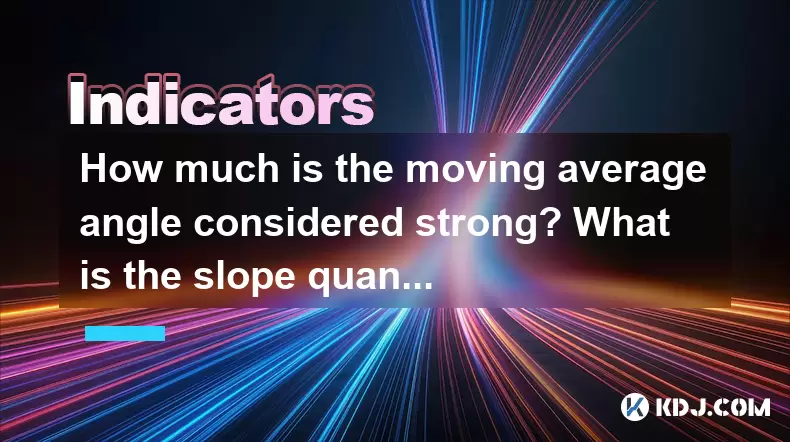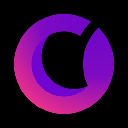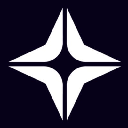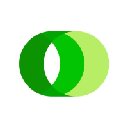-
 bitcoin
bitcoin $109523.663807 USD
-0.13% -
 ethereum
ethereum $4019.526508 USD
2.06% -
 tether
tether $1.000482 USD
0.00% -
 xrp
xrp $2.776815 USD
0.18% -
 bnb
bnb $958.942396 USD
0.12% -
 solana
solana $204.294698 USD
3.84% -
 usd-coin
usd-coin $0.999693 USD
0.00% -
 dogecoin
dogecoin $0.232115 USD
2.09% -
 tron
tron $0.338028 USD
0.84% -
 cardano
cardano $0.790920 USD
1.50% -
 hyperliquid
hyperliquid $44.871443 USD
5.60% -
 ethena-usde
ethena-usde $1.000322 USD
0.04% -
 chainlink
chainlink $21.034165 USD
2.60% -
 avalanche
avalanche $28.794831 USD
-0.54% -
 stellar
stellar $0.360466 USD
1.24%
How much is the moving average angle considered strong? What is the slope quantification standard?
A strong moving average angle, typically over 45 degrees, indicates a robust trend in cryptocurrency trading, helping traders decide when to buy or sell.
May 21, 2025 at 11:42 am

The concept of moving average angle and its strength is a critical aspect of technical analysis within the cryptocurrency trading community. Understanding the angle of a moving average can provide traders with insights into the momentum and potential trend direction of a cryptocurrency. In this article, we will delve into what constitutes a strong moving average angle and discuss the standards used to quantify the slope.
Understanding Moving Average Angle
A moving average is a widely used indicator in technical analysis that helps smooth out price data by creating a constantly updated average price. The angle of the moving average line on a chart represents the rate of change of the average price over time. A steeper angle indicates a stronger trend, whether it's upward or downward. Traders often look at the angle of moving averages, such as the 50-day or 200-day moving averages, to gauge the strength of a trend.
What Constitutes a Strong Moving Average Angle?
The strength of a moving average angle is typically assessed by its steepness. A strong moving average angle is often considered to be one that is greater than 45 degrees. This angle suggests a robust trend with significant momentum. However, the exact angle considered 'strong' can vary depending on the time frame and the specific cryptocurrency being analyzed.
For shorter time frames, such as intraday trading, a moving average angle might need to be even steeper to be considered strong, potentially around 60 degrees or more. Conversely, for longer-term trends, a slightly less steep angle, around 30 to 45 degrees, might still be considered strong due to the sustained nature of the trend.
Quantifying the Slope of a Moving Average
Quantifying the slope of a moving average involves calculating the angle of the line formed by the moving average over a specific period. The slope can be calculated using the following steps:
- Identify the start and end points of the moving average line over the period you wish to analyze.
- Calculate the difference in price between these two points.
- Calculate the difference in time between these two points.
- Use the arctangent function (ATAN) to find the angle of the slope. The formula for this is: Angle = ATAN((Price Difference) / (Time Difference)).
The result of this calculation will be in radians, which can then be converted to degrees by multiplying by 180/π. This gives you the angle of the moving average, which can be used to assess its strength.
Practical Application of Moving Average Angles
Traders use moving average angles to make informed decisions about entering or exiting trades. A strong upward angle might signal a good time to buy, as it suggests a strong bullish trend. Conversely, a strong downward angle might signal a good time to sell or short, indicating a bearish trend.
For example, if the 50-day moving average of Bitcoin shows an angle of 50 degrees, this could be interpreted as a strong bullish trend, prompting traders to consider buying. On the other hand, if the angle is -50 degrees, it might suggest a strong bearish trend, prompting traders to consider selling or shorting.
Tools and Software for Calculating Moving Average Angles
Several trading platforms and software tools can help traders calculate and visualize the angle of moving averages. Popular tools include:
- TradingView: This platform offers a wide range of technical indicators, including moving averages, and allows users to draw lines and calculate angles directly on the chart.
- MetaTrader 4/5: These platforms are widely used in the trading community and offer customizable indicators that can be used to calculate moving average angles.
- Excel: For those who prefer to do their own calculations, Excel can be used to calculate the angle of a moving average using the steps outlined above.
Interpreting Moving Average Angles in Different Market Conditions
The interpretation of moving average angles can vary depending on market conditions. In a bullish market, a strong upward angle on a moving average might confirm the overall trend and suggest continued growth. In a bearish market, a strong downward angle might confirm the bearish trend and suggest further declines.
However, in a sideways or choppy market, even a strong angle might not be as reliable. Traders should consider other indicators and market conditions alongside the moving average angle to make more informed decisions.
Common Pitfalls and Misinterpretations
While moving average angles can be a powerful tool, there are common pitfalls and misinterpretations that traders should be aware of. Over-reliance on a single indicator can lead to false signals. It's important to use moving average angles in conjunction with other technical indicators and fundamental analysis.
Additionally, short-term fluctuations can sometimes distort the angle of a moving average, leading to false signals. Traders should consider using multiple time frames and averaging periods to get a more comprehensive view of the trend.
Frequently Asked Questions
Q: Can moving average angles be used for all cryptocurrencies?A: Yes, moving average angles can be applied to any cryptocurrency. However, the strength of the angle and its interpretation may vary depending on the specific market dynamics of each cryptocurrency.
Q: How often should I recalculate the moving average angle?A: The frequency of recalculating the moving average angle depends on your trading strategy. For short-term trading, you might recalculate it daily or even intraday. For long-term trading, weekly or monthly recalculations might be sufficient.
Q: Are there any specific moving average periods that are best for calculating angles?A: The best moving average period for calculating angles depends on your trading style and the time frame you are analyzing. Common periods include the 50-day and 200-day moving averages, but shorter periods like the 10-day or 20-day moving averages can be used for more immediate trends.
Q: Can moving average angles predict future price movements?A: While moving average angles can provide insights into current trends and momentum, they cannot predict future price movements with certainty. They should be used as part of a broader analysis strategy that includes other indicators and market conditions.
Disclaimer:info@kdj.com
The information provided is not trading advice. kdj.com does not assume any responsibility for any investments made based on the information provided in this article. Cryptocurrencies are highly volatile and it is highly recommended that you invest with caution after thorough research!
If you believe that the content used on this website infringes your copyright, please contact us immediately (info@kdj.com) and we will delete it promptly.
- XRP Tundra: Dual-Token Innovation in the XRP Ecosystem
- 2025-09-27 20:25:12
- MUTM: Is This Crypto the Smartest Buy Now?
- 2025-09-27 20:25:12
- Crypto Millionaires: Unlocking Financial Freedom with the Right Investments
- 2025-09-27 20:30:01
- ETH Price Check: Crypto Analysts Favor These Moves Now
- 2025-09-27 20:30:01
- BlockchainFX, Bitcoin Hyper, and Crypto Presales: Finding the Next Big Thing
- 2025-09-27 20:30:01
- Galaxy CEO, Bitcoin, and the Powell Replacement: A $200K Prediction?
- 2025-09-27 20:30:15
Related knowledge

What is a tower bottom candlestick pattern? Does it have a high success rate?
Sep 22,2025 at 07:18am
Tower Bottom Candlestick Pattern Explained1. The tower bottom candlestick pattern is a reversal formation that typically appears at the end of a downt...

What is a black hole pattern in the MACD indicator? Is it a cause for concern?
Sep 21,2025 at 06:54pm
Bitcoin's Role in Decentralized Finance1. Bitcoin remains the cornerstone of decentralized finance, serving as a benchmark for value and security acro...

How can I use the psychological line (PSY) to determine market sentiment?
Sep 17,2025 at 02:19pm
Understanding the Psychological Line (PSY) in Cryptocurrency TradingThe Psychological Line, commonly referred to as PSY, is a momentum oscillator used...

How can I determine if a double top pattern has officially formed?
Sep 21,2025 at 03:18am
Understanding the Structure of a Double Top Pattern1. A double top pattern consists of two distinct peaks that reach approximately the same price leve...

What is the Golden Valley pattern on the moving average? Is it better than the Silver Valley pattern?
Sep 21,2025 at 02:54pm
Understanding the Golden Valley Pattern in Moving Averages1. The Golden Valley pattern is a technical formation observed in cryptocurrency price chart...

What does a death cross of the RSI in the strong zone (above 50) mean?
Sep 17,2025 at 10:54pm
Understanding the Death Cross in RSI Context1. The term 'death cross' is traditionally associated with moving averages, where a short-term average cro...

What is a tower bottom candlestick pattern? Does it have a high success rate?
Sep 22,2025 at 07:18am
Tower Bottom Candlestick Pattern Explained1. The tower bottom candlestick pattern is a reversal formation that typically appears at the end of a downt...

What is a black hole pattern in the MACD indicator? Is it a cause for concern?
Sep 21,2025 at 06:54pm
Bitcoin's Role in Decentralized Finance1. Bitcoin remains the cornerstone of decentralized finance, serving as a benchmark for value and security acro...

How can I use the psychological line (PSY) to determine market sentiment?
Sep 17,2025 at 02:19pm
Understanding the Psychological Line (PSY) in Cryptocurrency TradingThe Psychological Line, commonly referred to as PSY, is a momentum oscillator used...

How can I determine if a double top pattern has officially formed?
Sep 21,2025 at 03:18am
Understanding the Structure of a Double Top Pattern1. A double top pattern consists of two distinct peaks that reach approximately the same price leve...

What is the Golden Valley pattern on the moving average? Is it better than the Silver Valley pattern?
Sep 21,2025 at 02:54pm
Understanding the Golden Valley Pattern in Moving Averages1. The Golden Valley pattern is a technical formation observed in cryptocurrency price chart...

What does a death cross of the RSI in the strong zone (above 50) mean?
Sep 17,2025 at 10:54pm
Understanding the Death Cross in RSI Context1. The term 'death cross' is traditionally associated with moving averages, where a short-term average cro...
See all articles









































































